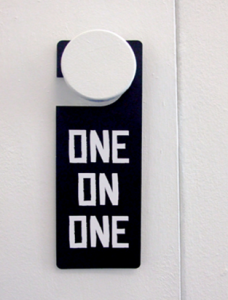 In Berlin, we are often used to finding ourselves at the openings of art shows—be it in a gallery, “white box” or other independent spaces. Whichever one it is, we always struggle to establish a personal experience with each artwork within the art space. If nothing springs out of it, we tend to engage our own ideas about the artwork in its larger context. But in the process of making itself true, this connection that we try to establish with the artwork ends up being quite vague and inexplicable, and we may feel somewhat overwhelmed. Since these shows display the works of many artists at once, we may never have an authentic experience of all the works of art, or not even of anything close to this experience.
In Berlin, we are often used to finding ourselves at the openings of art shows—be it in a gallery, “white box” or other independent spaces. Whichever one it is, we always struggle to establish a personal experience with each artwork within the art space. If nothing springs out of it, we tend to engage our own ideas about the artwork in its larger context. But in the process of making itself true, this connection that we try to establish with the artwork ends up being quite vague and inexplicable, and we may feel somewhat overwhelmed. Since these shows display the works of many artists at once, we may never have an authentic experience of all the works of art, or not even of anything close to this experience.
In order to feel truly engaged in what the exhibitions I visited were about, I used to hunt for brochures or other exhibition materials that would familiarize me with the concept of the visited shows, and would serve as a sort of curatorial statements. It always seemed to me, though, that I was trying too hard to create some meaning out of a simple gallery visit.
However, the exhibition One on One at “Kunst-Werke Institute for Contemporary Art” (open from the 17th of November 2012 until the 17th of February 2013), enabled me to do something different. It offered me the means to address the stringent issue one confronts when experiencing an artwork: quite often we leave the gallery with an impression which does not synthesize into something coherent or meaningful, for that matter. The impression remains raw and hardly cultivates anything in the beholder. Yet for this show, the participating artists—Massimo Bartolini, Nina Beier, Joe Coleman, Trisha Donnelly, Geoffrey Farmer, Hans-Peter Feldmann, FORT, Günter K., Annika Kahrs, Robert Kusmirowski, Alicja Kwade, Renata Lucas, Yoko Ono, Blinky Palermo, Anri Sala, Jeremy Shaw, Tobias Zielony— created artworks which were meant to speak to one viewer at a time. The artworks had rooms of their own—individual and self-contained spaces.
These self-contained spaces invited the viewer for action, at times even confrontation, encouraging contemplation about the artwork, but also accommodating the need for qualitative time spent with it. Each room generated, or at least promised an immediate and undisturbed setting, where art, time and space can all be perceived in new ways. The feeling of both loss and possession was the one dominating the realm of my experience: I would be disarmed by the intimate conversation with the artwork, but at the same time I would have the feeling of holding something in my possession. It might not have necessarily been a better understanding of the artwork that I acquired, but rather the feeling that I got a hold of my own self in relation to each artwork within its space.
In the One on One exhibition space I had to adapt myself to some degree to each artwork’s specific terms. There was no angle to be imposed on me as a viewer in order to be able to examine a particular work of art. I would simply be in the space to which the artwork is bound, and explore the empty area surrounding the artwork and myself. I had to be the one who filled this space with meaning—meaning which would actually arise out of nothing. This experience was for me indeed something!
